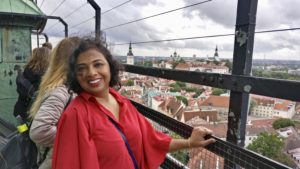 Set in the 1960s with the backdrop of the Nigerian Civil war, Half of a Yellow Sun could have very easily been a novel on the brutalities of war; gut wrenching realities weaved in the bloody fabric of violence. But instead, it evolves into a warm story of family and friends and the intricacies of their lives, strangely affected by the ensuing war. The story revolves around three distinct sections of the population – Ugwu, a poor village boy employed as a house boy, Olanna and her upper middle class and influential family settled in Lagos and Richard, an Igbo speaking white gentleman smitten not just by Olanna’s twin sister but also by the greater cause of the Nigerian society.
Set in the 1960s with the backdrop of the Nigerian Civil war, Half of a Yellow Sun could have very easily been a novel on the brutalities of war; gut wrenching realities weaved in the bloody fabric of violence. But instead, it evolves into a warm story of family and friends and the intricacies of their lives, strangely affected by the ensuing war. The story revolves around three distinct sections of the population – Ugwu, a poor village boy employed as a house boy, Olanna and her upper middle class and influential family settled in Lagos and Richard, an Igbo speaking white gentleman smitten not just by Olanna’s twin sister but also by the greater cause of the Nigerian society.
Olanna is the “illogically beautiful” daughter of an influential businessman based in Lagos. She is in love with the idealistic professor Odenigbo. Her complicated relationship with her ambitious twin sister Kainene traverses through undulating territories amidst war torn Nigeria.
The prose flows naturally through time and takes the reader from post independent Nigeria of 1960 to the war ravaged decadence of the late 60s. The post colonial restlessness eventually leading to the coup is captured vividly through the drawing room discussions of Odenigbo and his friends. With Olanna as the centerpiece of the novel, the story rushes through pre and post war times, changing the chemistry of her relationships.
The beauty of the novel is in the way the atrocities of the war has been described; the sheer nonchalance of the narrative and the guarded indifference that the characters put on bring out the best of Adichie. Be it the one time that Kainene witnesses a headless Ikejide running about and moments after that when she seemingly unperturbed, changes into a dress to head out for a safer house.
A piece of shrapnel, the size of a fist, wheezed past. Ikejide was still running and, in the moment that Richard glanced away and back, Ikejide’s head was gone. The body was running, arched slightly forwards, arms flying around, but there was no head. There was only a bloodied neck……
Richard did not look as Harrison went over to pick up Ikejide’s head and put it in the bag.
Or when Olanna feels distressed by a letter from her former lover and close friend Mohammed, because it insulted her current state of being – her having sold her wig among other things.
Mohammed’s letter incensed her; it insulted her reality. But he could not possibly know that they had no salt and Odenigbo drank kai-kai every day and Ugwu was conscripted and she had sold her wig.
Adichie’s fluid writing jolts the reader back to harsh reality through the simplest of situations – a time when it was difficult to understand if a girl’s growing belly was due to her pregnancy or the growing kwashiorkor. There is an instance where Ugwu looks on a band of malnourished children playing a war game and contemplates if the boy who was constantly getting shot at and playing dead was doing it on purpose to get some rest, lying down on the grass.
The World was Silent when We Died
Throughout the novel, there are postscripts titled The World Was Silent When We Died, narrations depicting snippets of prose written in the third person describing and summarizing the events as they unfold. What touches the reader the most is the title – over a million Nigerians died due to the Civil War while the world looked on in solemn condemnation.
My rating 5/5
Buy this book Half of the Yellow Sun







